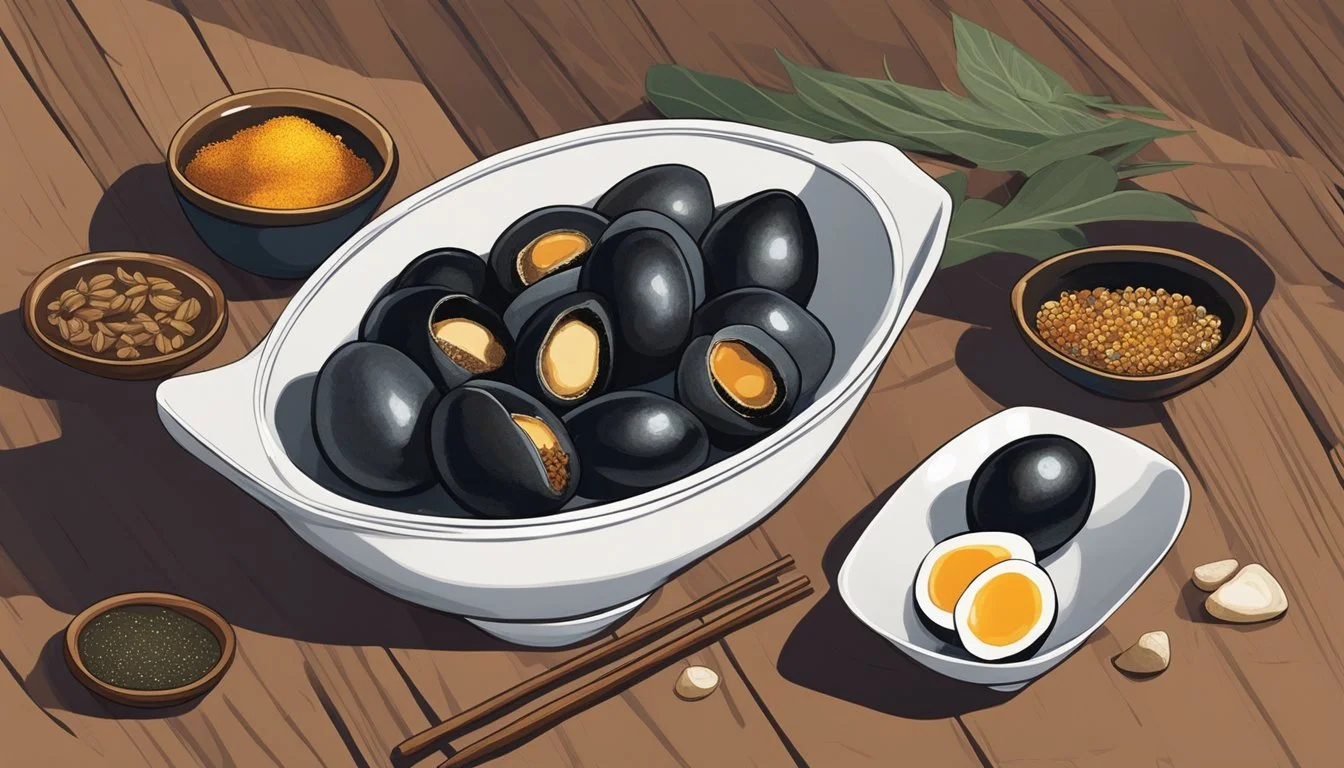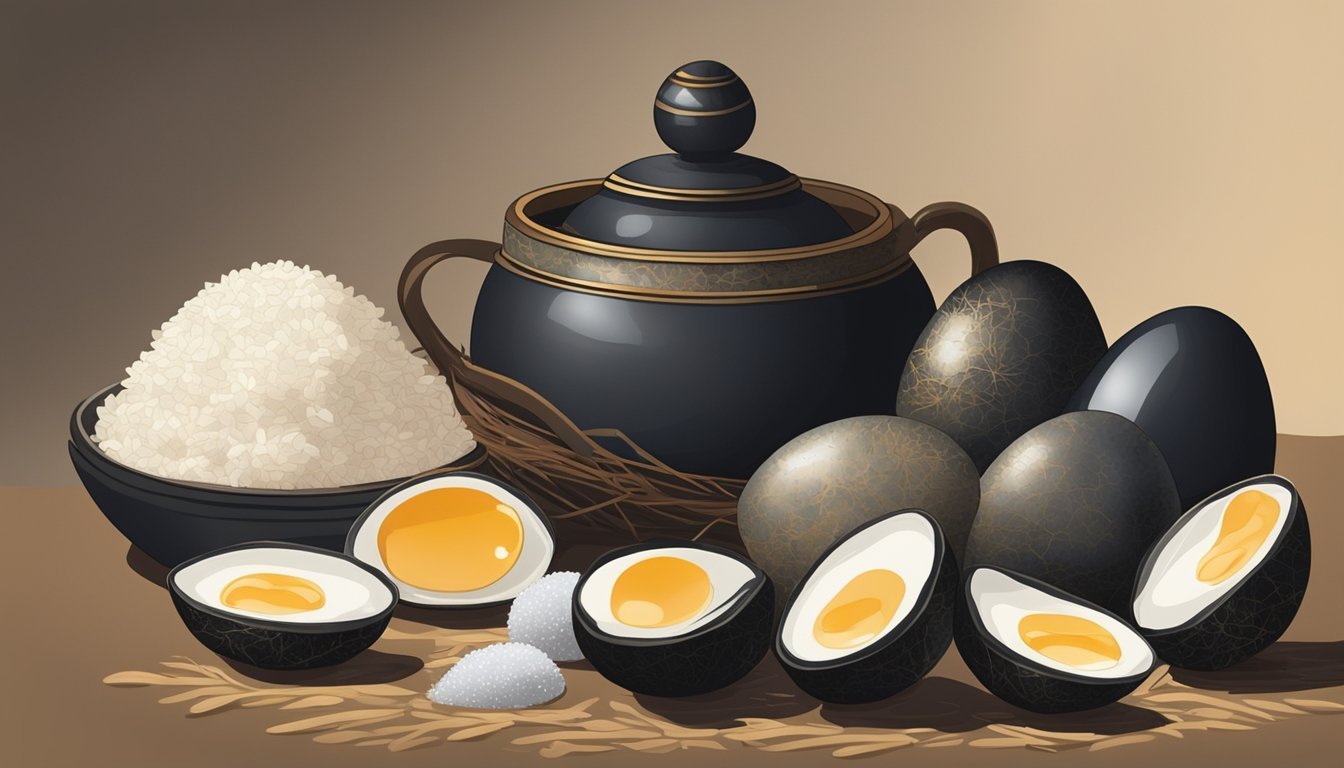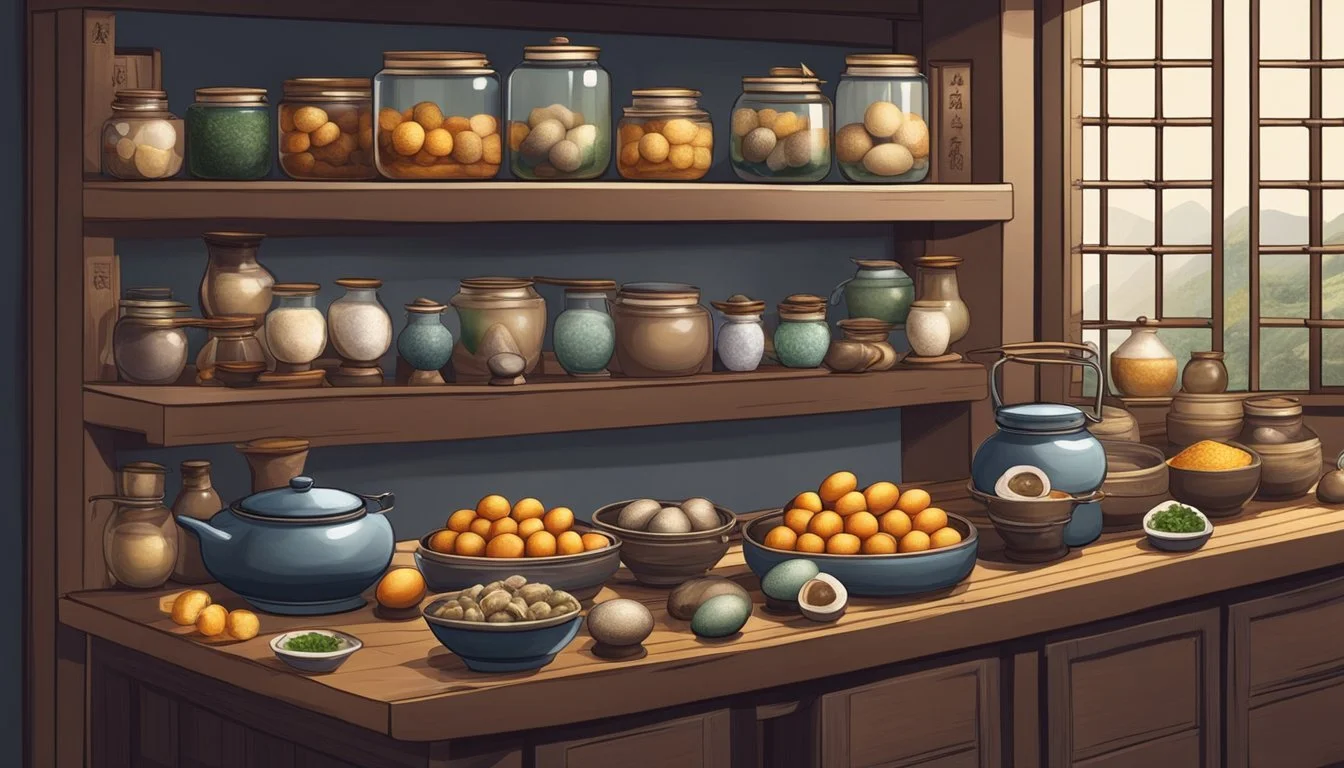Century Eggs Unveiling the Preservation Mastery in Chinese Cuisine
Century eggs, a jewel in the crown of Chinese cuisine, are a fascinating testament to the ingenuity of traditional food preservation techniques. Known as pidan in Mandarin, these preserved eggs are celebrated for their unique flavors and textures that are the result of an intricate curing process refined over centuries. Although their precise origins are shrouded in the mists of history, it's broadly accepted that they have been a part of Chinese culinary heritage since at least the Ming Dynasty, indicating that they have been savored for several hundred years.
The transformative process that gives century eggs their characteristic appearance and taste involves wrapping eggs in a mixture of clay, ash, salt, quicklime, and rice hulls. This encasing is essential to creating the alkaline environment which causes the eggs to cure rather than spoil. During this period, which can last from several weeks to months, the egg undergoes chemical changes; the yolk becomes creamy with a complex, savory flavor, while the egg white turns into a jelly-like consistency with a translucent appearance.
These eggs, usually made from duck, (What wine goes well with duck?) chicken, or quail (What wine goes well with quail?) eggs, have transcended mere sustenance to become a culinary artifact symbolizing the depth and breadth of food preservation arts in China. They are more than just an unusual delicacy; century eggs embody the balance between tradition and innovation — a balance that is at the heart of Chinese cuisine itself. Serving as a connection to the past and a staple in modern kitchens, these eggs are a striking example of the legacy and continual evolution of food culture in China.
Historical Background and Cultural Significance
Century Eggs hold a profound place in Chinese cuisine, known for their history reaching back to earlier dynasties and their importance during cultural festivities.
Origins and Evolution in Chinese Culture
The Century Egg is not only a testament to Chinese culinary ingenuity but also to its enduring cultural heritage. It is believed that Century Eggs originated during the Ming Dynasty, if not earlier, according to some historical accounts. The preservation technique likely developed out of necessity to store food, showcasing how the intersection of practical needs and creativity can lead to lasting traditions. This traditional Chinese dish remains popular, reflecting the culture's appreciation for preserving and savoring flavors from the past.
Century Egg in Dynastic Eras
During the Qing Dynasty, China experienced significant prosperity, which allowed for culinary arts to flourish. Century Eggs were being refined in this period, exhibiting advancements in the preservation methods and becoming a delicacy that graced the tables of many, from common folk to the noble classes. They exemplify a part of the rich tapestry of Chinese preserved food that sustained and delighted generations over time.
Symbolism and Occasions
In Chinese culture, food often carries deeper meanings. Century Eggs are no exception; they are sometimes consumed during special occasions and festivals, symbolizing a connection to history and the passage of time. This connection is auspicious, representing the hope for longevity and prosperity. As a result, Century Eggs are more than just nourishment; they're culturally significant morsels that carry the weight of tradition with every bite.
Understanding Century Eggs
Century eggs are a traditional Chinese delicacy known for their distinctive preservation process. They offer a complex texture and flavor profile that distinguishes them from other types of preserved eggs.
What Makes a Century Egg
Century eggs, also referred to as preserved eggs, are traditionally made using duck eggs, though chicken and quail eggs are also used. Preserved eggs are transformed through a meticulous curing method that involves a mixture of clay, ash, salt, quicklime, and rice hulls. The eggs are coated with this mixture and then cured for several weeks to a few months.
Ingredients Used: Clay, Ash, Salt, Quicklime, Rice Hulls
Common Types of Eggs: Duck, Chicken, Quail
The Chemical Process of Preservation
During the curing process, a series of complex chemical reactions occur. The high pH from the quicklime and the alkaline materials lead to the fermentation of the eggs. Over time, the proteins within the egg yolk and white are broken down into simpler forms.
Proteins are broken down into amino acids and peptides.
Amino acids contribute to the development of a rich savory flavor, with hints of umami.
The formation of compounds such as ammonia occurs, influencing the final taste and aroma.
Texture and Flavor Profile
The transformation of century eggs results in a unique texture and flavor. The egg white becomes a dark brown, translucent jelly with a salty, savory flavor. The yolk turns creamy with a complex, umami taste, often likened to certain cheeses.
Texture Comparisons:
Egg White: Jelly-like, firm
Yolk: Creamy, rich
The preserved egg's distinctive flavor is appreciated by many for its bold combination of salty and savory notes, alongside a profound depth brought on by the umami.
Ingredients and Production
Century eggs, a staple in Chinese cuisine, are made through an intricate preservation process involving specific ingredients that result in a flavor profile unique to the preserved egg delicacy. The traditional method, respected for centuries, has also seen adaptations with modern culinary practices enhancing safety and taste.
Traditional Ingredients
Key ingredients in the traditional production of century eggs include:
Clay: Forms the base covering substance for the eggs.
Ash: Sourced commonly from wood and mixed with clay to create the curing paste.
Salt: Essential for its preservative properties.
Quicklime: Also known as calcium oxide, it increases the alkalinity of the mixture.
Rice hulls: Often mixed into the curing paste for its insulating properties.
The traditional curing process involves coating eggs in a paste made from these ingredients. The eggs are then wrapped in rice hulls for insulation and left to preserve for several weeks or months. During this time, the egg's flavor and texture transform, and a distinctive pine-patterned appearance develops on the egg white due to the reaction of the egg proteins with the alkaline mixture.
Modern Variations and Methods
In modern methods, safety and consistency have prompted slight changes, such as:
Alkaline solution: A prepared mixture of salt, water, and alkaline ingredients such as lye or sodium carbonate.
Temperature control: Maintaining consistent temperatures between 15 to 20°C through the curing process.
While the traditional ingredients are still used, modern production often involve dissolving alkaline substances in water to create a more controlled curing environment. Safety precautions, such as proper ventilation when preparing alkaline solutions, are emphasized. This modern approach streamlines the production and ensures a consistent quality of century eggs, which remain a beloved addition to Chinese dishes.
Consumption and Culinary Uses
Century eggs, with their transformed flavors and textures, are incorporated into various Chinese dishes. They can range from a snack to an integral component of sophisticated meals.
Common Dishes and Pairings
Congee: Century eggs, also referred to as pine-patterned eggs due to the intricate pattern that emerges on the egg white during preservation, are often diced and stirred into rice porridge or congee. This dish enhances the creamy texture of the congee with the rich, complex flavors of the eggs.
Dumplings and Salads: Slices of century eggs can be found in dumplings or mixed into salads for a punch of savory and slightly sulfuric taste.
Chilled Tofu: A popular summer dish involves topping chilled tofu with wedges of century eggs, combining the creamy textures of both ingredients while contrasting the subtle flavor of tofu with the robust taste of the eggs.
Serving Suggestions
Straight From the Shell: The eggs can be consumed without further preparation, often accompanied by pickled ginger to balance their strong flavor.
Garnish on Rice and Tofu: Sprinkled over rice or tofu, they are typically drizzled with soy sauce and sesame oil for additional flavor.
In Cooked Dishes: When used in cooked dishes such as omelettes, century eggs impart a distinct taste that pairs well with milder ingredients like vegetables and meat.
Through these traditional pairings and uses, the unique taste of century eggs is celebrated in Chinese cuisine, demonstrating its versatility and long-standing cultural significance.
Nutritional Information
Century eggs offer a distinctive profile of nutrients that cater to various dietary needs. Their preservation process alters the nutritional makeup compared to fresh eggs, providing a different balance of vitamins and minerals.
Health Benefits and Concerns
Protein: Century eggs are a good source of high-quality protein, which is essential for muscle repair and growth. The preservation process does not significantly degrade the protein content, making them comparable to fresh eggs in this aspect.
Fat: The fat content in century eggs remains relatively similar to that of fresh eggs, though it may slightly vary depending on the specific preservation technique. Dietary fat is crucial for energy and the absorption of fat-soluble vitamins.
Iron: These preserved eggs are known to have a higher iron content than fresh eggs. Iron is vital for the body's oxygen transportation and energy metabolism.
Calcium: Preservation increases the calcium content of the eggs, as some methods use lime in the curing mixture. Calcium is important for bone health and normal muscle and nerve functions.
Minerals: Century eggs contain various minerals that are essential for good health. The presence of ash and other components in the preservation mixture may contribute additional mineral content, such as zinc and phosphorus, which play roles in immune function and bone health, respectively.
Consumers need to be aware that despite their nutritional benefits, century eggs should be eaten in moderation. Some preservation methods use heavy metals like lead oxide, which can be toxic. It is important to purchase century eggs from reputable sources that adhere to safety standards to avoid any health risks.
Regional Varieties and International Presence
Century eggs, a delicacy with a storied past in Chinese cuisine, manifest in various regional iterations across China and have garnered a global presence, adapting to different cultural tastes.
Century Eggs Across China
In China, century eggs are produced with distinct regional characteristics that cater to the local palate. Hunan province is renowned for its version, where the eggs acquire a creamy yolk and a smooth jelly-like white due to the unique processing methods. Dongguan in Guangdong Province also has its special recipe with eggs that typically have a stronger flavor.
Moving towards the south, Southern China, particularly Cantonese regions, favors a milder taste, whereas Sichuan province is known for a spicier kick to the preserved eggs. Anhui and Yunnan provinces have their own traditional methods that contribute to the diversity of century eggs found within China's vast borders. They are commonly found in markets and often incorporated into local dishes, showcasing the rich culinary tapestry of the country.
Hunan: Creamy yolk, smooth jelly-like white
Dongguan, Guangdong: Strong flavor
Southern China: Milder taste
Sichuan: Spicy flavor
Anhui/Yunnan: Unique local methods
Century Eggs Around the World
Century eggs have transcended Chinese borders and found a place in the international foodscape. In Taiwan, they are savored for their delicate texture and are often paired with tofu. Vietnam also enjoys these eggs, incorporating them into various traditional dishes. As Chinese diaspora communities have established themselves globally, the appeal of century eggs has spread, bringing this traditional delicacy to new audiences who appreciate its unique flavors and textures. In countries with significant Chinese populations, century eggs have been assimilated into the local food culture, sometimes modified to align with local tastes and preferences.
Taiwan: Delicate texture, often paired with tofu
Vietnam: Incorporated into traditional dishes
Global Chinese communities: Adapting century eggs to local tastes and preferences
Myths and Misconceptions
Century eggs, a staple in Chinese cuisine, are often misunderstood due to certain myths. This section aims to clarify these misconceptions, enhancing the reader's understanding of century eggs.
Debunking Common Myths
Myth: Century eggs are soaked in horse urine.
Fact: They are not made with horse urine. The preservation process involves a mixture of clay, ash, salt, quicklime, and rice hulls.
Myth: Century eggs are actually a thousand years old.
Fact: Despite the name "thousand-year-old egg," the preservation period is only several weeks to a few months. They are not aged for a millennium.
Conservation and Future Trends
Century eggs have a longstanding history within Chinese cuisine, recognized for their unique preservation process. Recent focus on sustainability and innovation is driving changes in how these eggs are produced and how they might evolve.
Sustainable Practices in Production
In the production of century eggs, traditional methods utilize a blend of clay, ash, salt, quicklime, and rice hulls. These ingredients are readily available and have sustained the practice for centuries. However, there is a shift towards sustainable sourcing of materials to reduce environmental impact. For instance, producers are now more careful in sourcing kansui (alkaline water) and xiaxian county soil—known for its integral role in the preservation process—to ensure that these key materials are obtained responsibly without depleting local resources.
Innovation and The Future of Century Eggs
Enterprises are exploring alterations to the traditional egg preservation recipe to shorten the curing time and improve safety. This includes:
Incorporating new technologies: Methods that maintain taste and texture with a reduced environmental footprint.
Potential health benefits: Investigating healthful additives to enhance the nutritional profile of century eggs.
Innovation in production is not only about making the process more eco-friendly but also about adapting century eggs to a modern palate that values both tradition and contemporary culinary trends. The future of century eggs lies in balancing their rich culinary history with the demands of today's conscious consumers.







